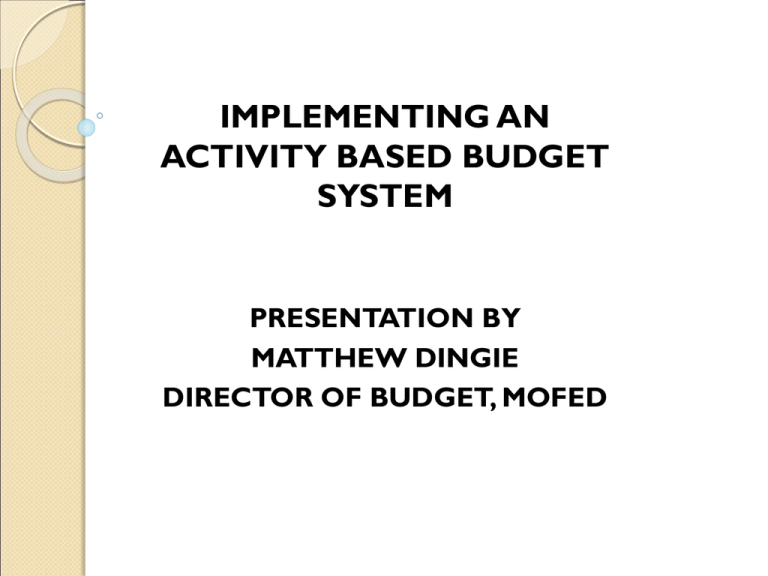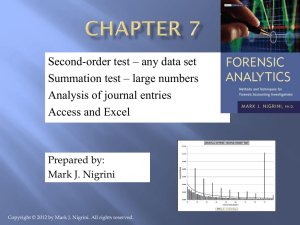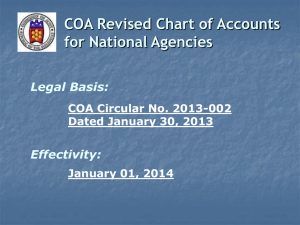implementing an activity based budget system presentation by
advertisement

IMPLEMENTING AN ACTIVITY BASED BUDGET SYSTEM PRESENTATION BY MATTHEW DINGIE DIRECTOR OF BUDGET, MOFED CONTENTS Definition of Activity Based Budget System Features and Advantages of an ABB System The 27 Digit COA and the ABB System Coding of Activities in the FY2014 Estimates Use of relevant inputs to cost Activities Use of the Revised MTEF PETS Form I Conclusion Definition of Activity Based Budgeting System Activity based budgeting is an approach to the budgeting process that focuses on identifying the costs of activities that take place in every area of an organization, and determining how those activities relate to one another. The data regarding those activities and how they relate to one another is used to establish goals that allow the organization to move forward. Activity based budgeting is more concerned with what is being done within the organization, how those actions or activities work together, and then allocating funds to each activity based on how much it will cost to successfully complete those activities. Features and Advantages of an ABB System More realistic - involves looking inward at activities and costs rather than basing the budget on line items; Creates financial forecasts that are more accurate; Prompts the organization to make the most efficient use of its resources; Minimizes wasteful spending within an organization - the analysis of each activity and its contribution to the ongoing success of the organization means that any activities that do not appear to relate to other activities within the organization structure may in fact be unnecessary; Changes the way in which costs are counted; It is easier to align with the organization’s Strategic Plan Provides more flexibility in reallocation of funds than with line budgeting systems It helps in setting performance targets and hence suitable for monitoring The 27 Digit COA and the ABB System Understanding the COA 1st – 3rd Digits – Sector and MDA - eg. 129, 301, 201 4th – 5th Digits – Division within MDA – eg. 12901, 30101, 20101 6th – 7th Digits – Cost Centre within MDA – eg. 1290101, 3010105 8th -10th Digits – Fund Source segment and type of financing 11th – 18th Digits – Activity/Project segment 11th Digit – PRSP Pillar; 12th Digit – Thematic Area in PRSP; 13th Digit – PRSP objective; 14th – 16th Digits – PRSP Activities in MDA Strategic Plan; 17th – 18th Digits – PRSP sub-activities 19th – 23rd Digits – Location 24th – 27th Digits – Object of Expense or Revenue Coding of Activities in the FY2014 Estimates Illustration 132001-000-72132100 7 – Pillar 7 (Governance and Public Sector Reform); 72 – Thematic Area 2 (Public Financial Management); 721 – Policy Objective under 1 Thematic Area 2 (To have a more efficient and effective State management of public financial expenditures); 721321 – Activity #321 under Policy Objective 1 (Developing a quality accounting class within the public service); What kinds of Input will go into the implementation of this Activity (Note – Flexibility Vs Relevance) – Local Training? (Yes), Stationery?(Yes), Computer Running Costs? (Yes), Generator Running Cost? (No) Freight & Port Charges? (No) Use of relevant inputs to cost Activities All the Standard Object Codes are available to utilise in the costing of activities However, only the relevant ones should be used for a specific activity Object Codes that cannot be justified will be eliminated and hence reduce the cost of the Activity Use of the Revised MTEF PETS Form I Additional Features: Description of Activities Objective(s) of the Activities Scope, Coverage and Duration of Activities Target Beneficiaries and Expected Outcome Conclusion The use of the ABB System ensures efficient and effective budget execution Avoids duplication of resources especially for Foreign Funded Programmes Improved participation of Budget Committee members in developing budget request proposals THANKS FOR YOUR ATTENTION











